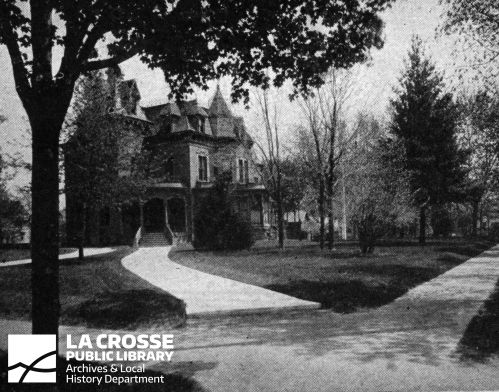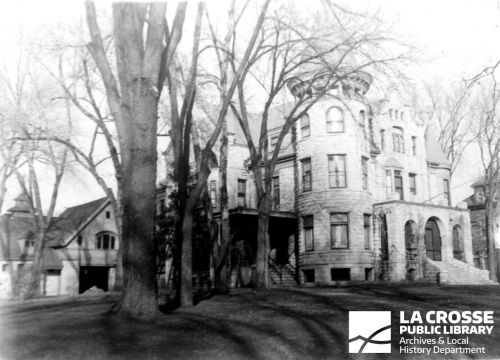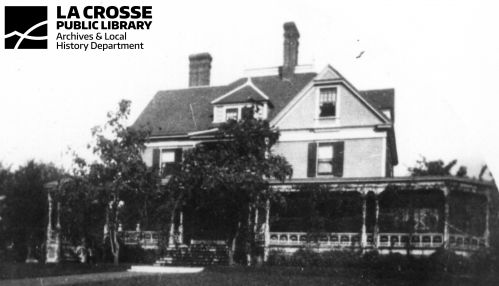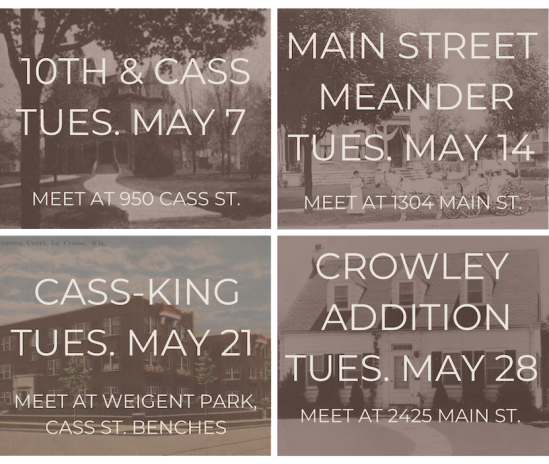
Footsteps Returns!
(written by Jenny DeRocher, Archives staff)

Have you ever wondered…
What did Main Street look like at the turn of the 20th century? Were there any historically prominent houses that are no longer there?

Gone now, this was the Michael Funk House. It was built in 1890 and stood where today’s Faith Lutheran Church is between the 1400 and 1500 blocks of Main St. Michael Funk’s three sons William, Edward, and Arthur Funk were all unmarried and lived together in this home until the time of their deaths. These three brothers helped found the La Crosse Rubber Mills, which was one of the largest employers in the city throughout the 20th century.
What’s the story behind the castle on Cass?

The Castle on Cass was designed for wealthy lumber baron Nymphus B. Holway and built in 1891. N. B. Holway died before the house was complete. Jess Holway, his wife, lived in the home until the 1920s. In 1922, the Diocese of La Crosse purchased the property to serve as a new Bishop house (which had previously been at the old Siena Hall at 11th and Ferry Streets). The Catholic Church owned the home until the 1970s. The owners since have restored both the exterior and the interior to its original appearance, while also updating it.
Where did George Coleman Poage, first African American to win an Olympic medal, grow up?

George Coleman Poage’s family came to La Crosse in 1884 from Hannibal, Missouri, possibly because of lumber baron Albert Wells Pettibone. The Pettibone family moved from Hannibal to La Crosse around the same time as the Poages. Right away, George’s mom and dad, Anna and James, had jobs lined up at the Pettibone estate at145 S. 8th St. In 1885, the Poages moved into the coach house on the Easton estate, here at 1327 Cass St. After James died in 1888, Anna switched jobs to the Easton home. George lived here for most of his early life, until he graduated from La Crosse High School in 1899. He then went on to be a student at UW-Madison, where he graduated from in 1903. In 1904, Poage became the first African American to win an Olympic medal at the St. Louis Games.
If you want answers to questions like these, you’re in luck!
Footsteps of La Crosse is a walking tour series run by the Archives Department. Since its inception in 2008, Footsteps has delivered free and accessible self-guided walking tours of La Crosse neighborhoods. These tours are meant to connect the community with our built environment through the history of La Crosse families, businesses, and architecture.
On the Footsteps website, there are 13 tours available. This website is mobile-phone friendly and also provides a downloadable and printable .pdf of each tour. Some tours also have sound bites of architecture historians to guide users on the tour with audio. Each tour has historic photographs from the La Crosse Public Library Archives, UW-L Murphy Library Special Collections and Area Research Center, La Crosse County Historical Society, and Dr. Les Crocker (local architecture historian).
On top of these always available self-guided tours, Archives staff also hosts a weekly series in May and September every year to give guided versions of the tours. They give you the opportunity to learn new things and ask questions from the Archives staff member who serves as the tour guide.
As tour guides have shifted through the years, the content of the tours have shifted as well. This year, Jenny (Associate Archives Librarian) will begin as the new tour guide. Due to new community interest in the history of La Crosse from different perspectives, the Archives Department is making some changes to the Footsteps tours. Though the architecture pieces will still be available, the focus of Footsteps will change to instead be about the people and spaces of La Crosse history.
Rather than focusing on the wealthy, famous businessmen that owned the houses featured on these tours—whose stories have been told countless times—the new content will instead guide you through how these houses impacted the often overlooked people in La Crosse’s history. Footsteps tours will tell a story of class, culture, and the impact the featured stops had on the community.
This May, join Jenny in four of the new Footsteps tours. Each tour will start on Tuesday nights at 6:30pm and should end around 8pm. Tours are free and open to the public.

(Image reads: May 7: 10th & Cass, meet at 950 Cass St.; May 14: Main Street Meander, meet at 1304 Main St.; May 21: Cass-King, meet at Weigent Park, near the Cass St. benches; May 28: Crowley Addition, meet at 2425 Main St.)
Please register for tours at www.footstepsoflacrosse.org to reserve a space on the tour. You can also contact the Archives by phone at (608) 789-7136 or by email at archives@lacrosselibrary.org for more information or help registering.

